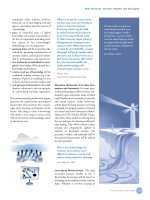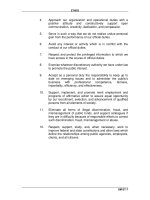Making globalization work phần 9 pdf
Bạn đang xem bản rút gọn của tài liệu. Xem và tải ngay bản đầy đủ của tài liệu tại đây (85.54 KB, 17 trang )
Statement by Ms. Valentine Sendanyoye
Rugwabiza, Deputy Director-General,
World Trade Organization
I
t is a distinctive privilege to be here today — in this historic and beautiful city,
Istanbul — to share with you our views on how the multilateral trading system
could contribute to ‘making globalization work for the LDCs’. Through you,
Honourable Minister, I commend the Government of Turkey for hosting this
conference which is a clear reflection of the commitment of your Government to sup-
port the LDCs’ efforts to better integrate into the global economy.
One of the most visible aspects of globalization is the multilateral trading system.
Today, there is a broad consensus that trade opening plays a vital role in growth and
development. Trade opening and rule-making are indeed major goals of the WTO.
But, as of today, a number of the current substantive rules of the WTO do perpetuate
some bias against LDCs and other developing countries. This is true, for example,
with rules on subsidies in agriculture that allow for trade-distorting subsidies which
tends to favour developed countries. This is also true when we look at the high tariffs
that many developed countries apply on imports of agricultural and industrial prod-
ucts, in particular from developing countries. As the WTO’s director-general, Pascal
Lamy, often says, while the political decolonization took place more than 50 years
ago, we have not yet completed economic decolonization. A fundamental aspect of
the Doha Development Agenda is therefore to redress the remaining imbalances in
the multilateral trading system and to provide LDCs and developing countries with
improved market opportunities.
But while trade is an essential ingredient, we also know that trade opening is not
a panacea for all the challenges of development. Nor is it necessarily easy to accom-
plish, or be effective, unless it is embedded in a supportive economic, social and
political context.
My point is that trade opening is necessary but not sufficient in itself to ensure
automatic development benefits for the people in LDCs. In fact, trade opening can
only be politically and economically sustainable if it is complemented by flanking
policies which address, at the same time, capacity problems — human, bureaucratic
or structural — and the reforms that support an inclusive growth. This is where trade
policy intersects with education and social security, with fiscal policies, with infra-
structures. This policy mix must be carefully considered: coherence between foreign
policy and trade, finance and development policies is paramount to making global-
ization work for LDCs.
If addressing policy mix is a difficult task in developed countries, which have the
necessary means to do it, it becomes a truly uphill battle in many LDCs. This is what
motivated placing Aid for Trade high on the WTO agenda, together and in parallel
with the Doha Round.
Aid for Trade aims at improving the capacity of developing countries to reap the
benefits of more open trade. For some developing members this will mean setting
up testing facilities and reliable institutions to help to ensure that exported products
meet the technical, sanitary and phytosanitary regulations and standards of export
134 Making Globalization Work for the Least Developed Countries
markets. For some others it would mean larger scale projects such as improving
transport infrastructure and trade logistics.
The WTO has limited activities in the field, mainly focused on training, which means
that the Aid for Trade initiative has been set up in collaboration with the UNDP, the
World Bank, UNCTAD, the IMF, regional development banks, the OECD and other agen-
cies such as the ECA who have brought their expertise to bear. The WTO will provide
the platform for monitoring and regularly reviewing whether Aid for Trade is being
adequately funded and delivering the expected results. In particular, we need to make
sure that donors translate their pledges to increase Aid for Trade into reality. We also
need beneficiaries to ensure that trade and growth priorities figure prominently in their
development assistance priorities and poverty reduction strategies. Finally, we also
need to work on better coordinating the assistance provided by donors.
To this end, in September and the first week of October, we will hold three regional
Aid for Trade reviews in Latin America, Asia and Africa, with the cooperation of the
respective regional development banks and the World Bank. All this will lead to the
first global monitoring and evaluation event which will be hosted by the WTO in
Geneva on 20-21 November.
In the meantime, I am also happy to report the progress achieved in the revamp-
ing of the EIF which is an Aid for Trade programme with limited coverage to LDCs.
Sweden is hosting in Stockholm on the 25th of September a donor’s pledging con-
ference for the Enhanced Integrated Framework.
Today’s announcement by the Government of Turkey sends a strong and unequiv-
ocal message to traditional and non-traditional donors that they need to translate
their promises to help LDCs address their supply-side constraints and build their
trade capacity into reality.
But Aid for Trade must be a complement to, not a substitute for, ambitious results
in the Doha Development Agenda.
Increasing trade and investment opportunities for developing countries and, in
particular, the LDCs, remains far and away the most important contribution that the
WTO can make to development.
Today, the Doha Round is at a crossroads: the path towards success or the slow
move towards a deep freeze.
WTO Members have pledged to conclude these negotiations around the end of
the year. But if this is to be achieved, we need key progress in agricultural subsidies
and tariffs on agriculture and industrial tariffs now.
What remains to be done is small compared to all the proposals already on the
table, which represents two to three times what was achieved in the last round of
negotiations (to mention a few examples of what will be lost if this round fail to con-
clude: DFQF for at least 97 percent of LDC exports in developed countries and some
developing countries, total elimination of export subsidies in 2013, more ambitious
reduction of subventions and tariffs on cotton, etc.). But what remains to be done is
also small compared to the potential benefits of rebalancing the multilateral trading
system in favour of LDCs and developing countries.
Indeed, reaching agreement on subsidies today depends on additional conces-
sions from the US equivalent to less than a week’s worth of transatlantic trade. It
depends on an additional handful of percentage reduction in the highest agricultural
tariffs by the EU and Japan. It depends on an additional handful of percentage reduc-
Statements 135
tion in the highest industrial tariffs by emerging economies such as Brazil or India. All
this to be done, not by tomorrow, but over a transition period of several years to
leave space for a smooth adjustment.
I hope all WTO members will bear the proportions in mind over the coming weeks
when they will be called upon to make the necessary decisions. Today, the challenge
is less economic than political. It is about making the multilateral trading system
deliver for development. It is about making globalization work for LDCs. I urge you
to remind your counterparts in developed countries and other developing countries
that there are billions of people who are counting on this deal to deliver on the
Millennium Development Goals.
Thank you for your attention.
136 Making Globalization Work for the Least Developed Countries
Statement by Mr. Abdoulie Janneh,
Executive Secretary, United Nations
Economic Commission for Africa
Trade and Investment
I
n its 2004 (skeptical) report, the World Commission on the Social Dimensions of
Globalization summarized how the world feels about globalization as follows
(Stiglitz 2006, page 8):
‘The current process of globalization is generating unbalanced outcomes,
both between and within countries. Wealth is being created, but too many
countries and people are not sharing in its benefits … Seen through the
eyes of the vast majority of women and men, globalization has not met
their simple and legitimate aspirations for decent jobs and a better future
for their children … Meanwhile, the revolution in global communications
heightens awareness of these disparities’.
Globalization has produced winners and losers, but mostly the former than the lat-
ter. For Least Developed Countries, globalization may potentially generate substan-
tial benefits but also important challenges.
In the area of trade, while trade volumes in LDCs have increased over the past
years, the relative share of this group of countries in world trade remains low and has
even declined in some regions. For example, Africa’s share in global exports in 2005
was 2.8 percent only, roughly equivalent to its 1991 value and less than half its peak
value of 6 percent achieved in 1980 (ERA 2007).
The main challenges include lack competitiveness for LDCs producers, tariff esca-
lation, biased trade regimes in developed countries (such as export subsidies), restric-
tive rules of origin in preference schemes, etc. The outcomes of key international
trade initiatives such as EPAs and the Doha round continue to be disappointing.
However, some recent developments in international trade arrangements carry
potential gains for LDCs:
• Duty-free quota-free market access: The agreement by developed countries (as
well as advanced developing countries that are in a position to do so) to grant
DFQF market access to LDCs will open new export opportunities. The key
challenge for LDCs is to undertake the necessary strategies to increase their
production capacity and competitiveness to take advantage of these new priv-
ileges. Monitoring of implementation of these dispositions is a perennial issue
in international trade agreements, which is likely to hinder progress in this area
as well.
• The fact that LDCs have no obligation for reciprocity in these arrangements
constitutes a major advantage that will allow them to keep adequate protec-
tion for domestic producers.
Statements 137
• The Aid for Trade Initiative is a major step that can help LDCs in strengthening
supply capacities, building trade-related infrastructure, and dealing with
adjustment costs related to trade liberalization. The success of this Initiative is
critical for the LDCs’ ability to fully take advantage of other trade provisions,
such as the DFQF market access discussed above.
With regard to investment, while globalization has increased investment flows
across regions, private capital continues to flow primarily among developed
countries and a selected ‘hot markets’ in the developing world. LDCs as a group
remain vastly on the sidelines of financial globalization.
• Globalization has increased competition for private capital, especially in the
context of liberalization of capital accounts.
• Liberalization of capital accounts has also exposed LDCs to higher risks of finan-
cial fragility, putting more pressure on macroeconomic policy and requiring
higher levels of policy coordination both within and across countries.
Given that LDCs are still unable to fill their financing gap with external private
capital, more efforts will be required to increase official non-debt-generating external
financing to increase the levels of investment and growth.
• In this regard, the commitments by developed countries to increase both the
proportion of aid going to LDCs and the share of untied aid going to LDCs con-
stitute a welcome step in the right direction.
• The delivery on these commitments for more non-debt-generating financing
for LDCs will reduce the debt burden for these countries, which will increase
their creditworthiness. This in turn, should increase the flow of private invest-
ment into these countries in the near future.
The contribution of United Nations Economic Commission for Africa (UNECA)
Support in capacity building for trade promotion and trade competitiveness
• UNECA provides specific support to LDCs to enhance their knowledge of issues
of special interest to them in the on-going Doha Round of trade negotiations as
well as the EPA negotiations; this is in the context of its overall support to the
African WTO Geneva group.
UNECA provides support in strengthening the capacity of LDCs in trade negotia-
tions as evidenced by their proactive and constructive participation in bilateral and
multilateral trade negotiations.
138 Making Globalization Work for the Least Developed Countries
Support in promoting investment and financial development
Key activities in this area include research and advisory interventions in
• strategies for development of capital markets at the national and regional level;
• strategies for mobilization and management of domestic resources;
• strategies for improving the domestic investment climate.
Energy
Least Developed Countries are poor and contribute marginally to the world economy.
According to the 2006 World Bank Global Economic Prospects, over 300 million peo-
ple in sub-Saharan Africa live in extreme income poverty of less than $1 per day, most
in African LDCs. This represents, according to the UN 2006 Millennium Development
Goals Report, 44 percent of the population of the region. Extreme poverty is manifest-
ed in reduced income and limited economic (domestic and industrial) productivity
that impact most areas — health, education, nutrition and industrial development.
However, recent analysis shows that over 23 countries in Africa are growing at
more than 5 percent. In order to sustain this growth, they will need to produce and
consume more and more energy. There is now ample evidence that energy is need-
ed to fuel most economic activities, achieve the MDGs, and to increase the competi-
tiveness of Africa’s industrial sector. It should therefore be of concern that most
African countries, in particular the LDCs, are currently facing a stiff energy crisis,
mainly due to a combination of factors that include: the negative impact of oil price
increases on net-oil-importing countries; the low generation capacities of hydro-
power dams due to unfavourable climatic conditions; and insufficient investment in
the power sector over the last few decades.
While the discovery of more and more oil reserves on the continent has attracted
the interest of the rest of the world to Africa, one should keep in mind that the con-
tinent has abundant renewable energy resources (hydraulic, geothermal, solar and
wind) that are barely tapped. Exploiting them would require considerable resources
that are beyond the capabilities of the countries alone, divided among numerous pri-
orities. For example, the IEA is of the view that Africa needs $250 billion of invest-
ments in power generation, transmission and distribution between 2001 and 2030 to
ensure universal electricity access.
Most African governments have taken measures to increase the investment frame-
work in their countries in order to enhance the role of the private sector and attract for-
eign investments. A recent ECA study found that efforts were undertaken to reform the
regulatory framework of the power sector and increase the performances of power util-
ities, but it is fair to say that these efforts fell short in attracting many independent
investors in the sector. It is hoped that accelerating the economic and, in particular,
energy integration of African countries could provide some solutions to the financing
gaps. Much more need to be done at country and regional levels with more pro-
nounced and concerted support from development partners to increase and sustain
the current observed overall economic growth rate on the continent.
Statements 139
Finally, it should be noted that LDCs are the most vulnerable countries to the nega-
tive impacts of climate change, despite the fact that their total contribution to the green-
house gas emissions responsible for global warming is negligible. They nonetheless
have to invest in more expensive clean energy technologies in order to reduce overall
global emissions. In order to do so, they should benefit from a larger global solidarity.
Information Communication Technology
The world is currently entering what is commonly referred to as the Knowledge Society,
which is driven by information and intellectual information products as the raw mate-
rials. In this context, the ability to transmit information over the information and com-
munications infrastructure is a key resource for any nation, including LDCs, to partici-
pate effectively in the global information society and to address the development
challenges. The successful deployment of ICTs can contribute to the development of
knowledge societies in the LDCs and contribute to bridging the digital divide. The
potential of information and knowledge to provide a competitive edge to economic
growth, is no longer a myth. ICT can be used as a catalyst for increased trade and eco-
nomic growth; it can reduce transaction costs and create new industries. The reduction
of transaction costs is working in both directions — better market access and higher
import competition. ICT is the driver of globalization. There are some ongoing efforts in
the LDCs to catch up with these evolving opportunities.
In the case of Africa, recognizing the important role of ICTs in facilitating the attain-
ment of development goals and responding to the challenges of globalization, the
Conference of African Ministers of Planning and Economic and Social Development
adopted the African Information Society Initiative in May 1996 as a common vision to
bridge the digital divide between Africa and the rest of the world, to create digital
opportunities and to speed the continent’s entry into the information and knowledge
economy. It was in this context that the ICTs, Trade and Economic Growth Programme
was put in place by ECA, supported by the Government of Canada to promote devel-
opment of policy environments favourable to electronic business and trade within and
amongst African countries and between Africa and the rest of the world. Case studies
are being carried out in six African countries, including LDCs.
Agriculture
• It is widely acknowledged that agricultural growth contributes to overall eco-
nomic development. There is overwhelming empirical evidence to support this
point, with very few exceptions where sustained economic development has
not been preceded by robust agricultural growth.
• But, does this relationship between agricultural growth and economic develop-
ment still hold in an increasingly globalized world?
• With regard to agricultural growth, considerable, and often, widening, inter-
regional disparities persist. We thus know of many developing countries that
have witnessed neither significant agricultural growth nor notable economic
development.
140 Making Globalization Work for the Least Developed Countries
• This is the case of most African countries where poverty and hunger remain
rampant and are expected to increase if the present trends in agricultural devel-
opment were to continue.
• African agriculture has yet to gain from globalization as the continent’s share of
global agricultural exports has fallen sharply from 15 percent in the mid-1960s
to some 5 percent now.
Impediments to agricultural development
• The transformation of African agriculture from its traditional subsistence state
to a modern and market-oriented sector is a precondition for greater participa-
tion in the global economy.
• Yet, this structural transformation process is seriously impeded by a range of
factors, including:
1. poor market access conditions at local/national, regional and internation-
al levels;
2. poor infrastructure and provision of public support services in rural areas;
3. high share of agro-climatically constrained land resources;
4. weak science, technology and innovation institutions to enhance productivity
and competitiveness of food and agricultural commodity value chains, espe-
cially for commodities and environments of particular importance for the poor;
5. tariff and non-tariff barriers; and
6. agricultural support policies and export subsidies from trading partners,
especially developed countries.
Can globalization make a difference?
• Globalization has resulted in the rapid growth of world trade, internationaliza-
tion of production by multinational corporations and declining information and
communications costs.
• Potential global trade benefits for agriculture in LDCs could arise from
the following:
1. the increased direct exposure to international competition and the resulting
possibility to access global markets and specialize in areas of comparative
advantage could yield high gains for this sector;
Statements 141
2. the indirect effects of increased international trade on the growth of non-
agricultural sectors changing the domestic demand for agricultural goods
both in quantity and quality;
3. the often unrecognized consequence of globalization in terms of lifestyle
changes including diet, particularly among the urban middle class, as a
result of income growth and increased global interconnectedness through
travel and communications.
• For African LDCs to harness this potential would require that:
1. African governments accord greater priority to agricultural and rural devel-
opment, and back such commitment by allocating adequate budgetary
resources to investment in infrastructure and agricultural support services;
2. African countries develop coordinated commodity value chains within a
regional integration framework to capture the full potential of comparative
and competitive advantage based on agro-ecological diversity and
economies of scales of regional scope; and
3. WTO negotiations on agriculture lead to fair agricultural commodity trade
and market access, including substantial reduction in trade-distorting agri-
cultural support policies and export subsidies from developed countries.
142 Making Globalization Work for the Least Developed Countries
Statement by Ms. Harriet Schmidt,
Director, United Nations Office
of the High Representative for the
Least Developed Countries,
Landlocked Developing Countries and
Small Island Developing States
H
olding this conference in Istanbul, one of the earliest cosmopolitan cities
of the world, is truly symbolic. Located on the crossroads of commercial,
economic, political and cultural routes, this city has, for centuries, been
bridging the East with the West and the South with the North, and pro-
moting dialogue and understanding among nations. It served as an inspiration for
poets and artists, scholars and musicians, merchants and politicians. It can similarly
serve as an inspiration and provide useful historical lessons for this conference, which
seeks to address the all-important question of the full and beneficial integration into
the world economy of the 800 million citizens of the LDCs who are not benefiting
from globalization.
As a concept, globalization means a more interdependent world, where the
events in one corner echo in others. It also means a more integrated world with
shared values, interests, concerns, responsibilities and greater degree of solidarity
among its peoples. Paradoxically, as some countries get more integrated and
prosperous, others get more marginalized and isolated. Worse, those privileged
enough to be within the high walls of the global village tend to forget about those
left outside.
This is the sad reality for the LDCs. While globalization has, over the last 30 years,
expanded trade, increased economic output and created unparalleled wealth in
global terms, the LDCs have failed to reap its benefits. Accounting for 12 percent of
the world’s population, they receive less than 2 percent of FDI flows. Furthermore,
this minute amount of FDI is highly concentrated in oil and mineral rich LDCs. The
share of LDCs in world merchandise exports dropped from 3 percent to 0.7 percent
between the 1950s and the present decade. Similarly, between the 1970s and the
1990s, their share in agricultural exports dropped from 3.3 percent to 1.5 percent. In
the last 30 years, the number of people in extreme poverty in Africa, home to 34 of
the 50 LDCs, has doubled. These setbacks are the more striking when one considers
the international initiatives that have been undertaken to increase access of LDCs to
international markets, promote economic growth and reduce poverty.
Globalization has failed to benefit LDCs for many reasons. Internally, LDCs contin-
ue to face daunting structural constraints inherited from the colonial past. Extreme
poverty, insufficient financial resources, inadequate physical and social infrastruc-
ture, lack of skilled human resources and weak institutional capacities, not to men-
tion the challenge of HIV/AIDS, malaria and tuberculosis, inhibit their growth and
jeopardize their sustainable development.
Statements 143
Externally, globalization has been largely driven by the industrial economies’
need for market and investment opportunities abroad, engendered by the modern
technological revolution. As a result, the rules and structures of global governance
that have emerged to manage this process do not reflect the special needs and eco-
nomic interests of the LDCs, late-comers to the process of globalization. Neither the
Uruguay Round, which was signed in 1994, nor the wavering Doha Round, which had
been billed as a development round, has so far succeeded in addressing the special
needs of the LDCs. While the ‘Development Package’ agreed at the WTO Ministerial
Conference in Hong Kong in December 2005 was a positive step, it fell far short of the
target of DFQF market access for all the products from all LDCs set by the Brussels
Programme of Action. Even without considering the non-tariff barriers, there are
genuine concerns that the loopholes in the Doha Development Package could be
exploited by the industrial countries to keep out products in which LDCs are competi-
tive. The lack of any significant progress in elimination of agricultural subsidies in the
industrial countries and in the liberalization of the international labour market, which
would produce quick gains to the LDCs, are clear indications of just how much the
global economic regime remains skewed against the LDCs.
If the force of globalization continues on the path of the last 30 years, it will com-
pletely sweep away the LDCs. It is therefore the moral and political imperative of the
international community to ensure that LDCs not only benefit from the opportunities
created by a more integrated world economy, but that they also play their rightful
role in shaping its nature. Globalization should address, not accentuate, the world’s
challenges. We are not short of ideas on what needs to be done to achieve this goal.
Neither is the world short of the resources and technology needed to make global-
ization beneficial to all. In the Brussels Programme, the LDCs and their development
partners have agreed on goals and targets and identified polices and measures in
pursuit of those goals. What is lacking is the political action to translate these com-
mitments into reality.
In this connection, I commend the actions announced this morning by the
Government of Turkey to enhance its support to the development efforts of the LDCs.
I encourage the Government of Turkey and other development partners to continue
taking tangible actions in support of the LDCs.
Making globalization work for the LDCs calls for meeting global commitments on
development aid, debt relief, trade and trade related capacity-building, and reform-
ing the multilateral trading and financial systems by placing at their centre the needs
of the poorest nations. This should be a major economic and political undertaking for
governments, multilateral institutions, the private sector and civic institutions if we
want to achieve a truly global community.
144 Making Globalization Work for the Least Developed Countries
Keynote speech by H.E. Mr. Benjamin
Mkapa, former president of the
Republic of Tanzania
Conference Chairperson,
Participants,
Ladies and Gentlemen,
G
lobalization has become an all-encompassing word, exchanged and
bandied about worldwide, sometimes touted, most times vilified, to
describe the global process of our time.
It is a process examined from political, economic and social perspec-
tives. But the most dominant and fervently discoursed perspective is its economic
impact on the evolving global economic order.
The thematic title of this conference assumes that globalization’s evolutionary
process to date does not work for least developed countries. I agree with this prog-
nosis 150 percent. But let me start by acknowledging the protagonists on both sides
of the debate.
There are those in the developed countries who advocate or mitigate the effects
of the present structure and rules of globalization on the developing countries, and
in particular, the least developing countries of Africa. In their view, these LDCs do not
profit adequately from present systems because they do not engage in the process
seriously, diligently and efficiently; that because of inertia they are not positioning
themselves to use their comparative advantages to benefit from a global free market
system. To such people, the current structure, rules, and process of globalization offers
an assured, sustainable route to global order.
Then there are those in developing countries, especially in LDCs, who see the
process of globalization as weighing heavily against their interests of independence,
economic growth and equitable participation in a fair and inclusive global order. In
their turn, they see the structures and rules as being weighted mightily, if not exclu-
sively, in favour of the developed countries.
I come from Tanzania, one of the least of the least developed countries. Our
national language in Kiswahili, and the Swahili word for globalization is Utandawazi
— increasing global encompassing and interconnectivity. But to the majority of our
people — the learned and the pedestrian — the preferred word to describe this
phenomenon is Utandawizi — global massive theft or expropriation. It implies the
non-rewarding, acquisitive alienation by the developed, mostly western countries, of
LDCs’ natural resources, principally exclusive primary agricultural commodities
(coffee, cotton, sisal, tea) and minerals — in particular hydrocarbon fossil fuels and
uranium for weapons of mass destruction. To them, globalization is a symptom and
a route towards global disorder.
One realization on both sides represents common ground, namely that globaliza-
tion is a process which is inexorable, irreversible. It predates the ‘voyages of discov-
ery’ by the Portuguese and Spaniards around the world, or that of the Chinese to the
Indian and East African subcontinents. The search for knowledge about the extent of
Statements 145
our planet as well as the thirst for exchanges of goods and services between territo-
ries and continents predates the Second World War. It is a human instinct, and a
human surge. The process is unstoppable; it can be better managed.
Conference Chairperson,
Some historical facts and trends are incontrovertible. I restate them not in con-
demnation or apologetic plea for reparation, but as a factual reminder.
The institutions governing, and policies determining, the globalization processes
were established by the victors of the Second World War. These are the United
Nations and Bretton Woods institutions. The poverty, recovery, reconstruction, reha-
bilitation, economic, and especially currency instability that these institutions were
mandated to address and correct were those of the allied victors.
Many of the present day LDCs, especially in Africa, were non-states at the time of
formation of this development-and-sustainability paradigm, even although their citi-
zens played their part in victories in some of the theatres of the war. In economic
terms, the colonial territories were extensions of the metropolitan victorious econo-
mies. They had no voice in the formation of these managing, regulating, monitoring
and policy advocacy institutions, and at best were deemed as operationally marginal
appendages to the colonial power economies. Upon independence, they became
an afterthought.
The end of the cold war has magnified the influence of the victors in the Second
World War and, in particular, their influence over the institutions of the current
process of globalization promoted by the West — developed victor nations. By one
calculation, the economic power of the G8 represents 63 percent of the world’s GNP,
and they represent 50 percent of the total international trade in goods.
Today’s process of globalization therefore is modeled on the decisions and actions
taken by developed country governments of the North. The result has been to
strengthen the economic and geopolitical dominance of the North and to safeguard
its corporate interests. To make this process or model work for the developing coun-
tries, and especially for LDCs, will require substantial, principled changes in its insti-
tutions and operational rules. In the sixties and seventies, as many LDCs gained
political independence, a campaign was initiated for the emergence of the New
International Economic Order. The call was quickly silenced by the developed coun-
tries. The result has been the current widening economic disparities. It is time to
revisit the case for a new global economic order. There is a saying in Nigeria: ‘A day
of peace in times of stress is like a thousand days in Paradise’. In these times of stress,
LDCs should not wait for the advent of paradise; they must press for a century of
peace with development!
Conference Chairperson,
Five years ago, I co-chaired with the president of Finland, H.E. Tarja Halonen, a
World Commission on the Social Dimension of Globalization sponsored by the
International Labour Organization (ILO). In our report, we make the following telling
observation:
‘The current process of globalization is generating unbalanced outcomes, both
between and within countries. Wealth is being created, but too many countries and
people are not sharing in its benefits. They also have little or no voice in shaping the
146 Making Globalization Work for the Least Developed Countries
process. Seen through the eyes of the vast majority of women and men, globaliza-
tion has not met their simple and legitimate aspirations for decent jobs and a better
future for their children. Many of them live in the limbo of the informal economy
without formal rights and in a swathe or poor countries that subsist precariously
on the margins of the global economy. Even in economically successful countries
some workers and communities have been adversely affected by globalization.
Meanwhile, the revolution in global communications heightens awareness of
these disparities’.
Three years since our report and nearly two years since my retirement as president
of Tanzania, I am still an ardent believer in multilateralism and in the sharing of uni-
versal human values. I have however become less convinced that the international
community, particularly the rich industrialized world, is serious and committed to
delivering on their promises and commitments, to financially and through other
means (private investments) support the development of the poorer populations of
humanity, particularly the so-called least developed.
Among the 50 nations (with over 600 million population) classified by the UN as
LDCs, 34 of them are in sub-Saharan Africa. In 2004, the GDP per capita calculated by
PPP of LDCs was $1,270, compared with $4,306 for developing countries and $29,624
for members of the OECD. LDCs accounted for only 0.6 percent of global GDP and the
same proportion of global trade. In terms of human development outcomes, people
in LDCs in 2003 had a life expectancy of 51 years — 12 fewer than the average in
developing countries. LDCs adult literacy rate, 53 percent was significantly lower than
that in the developing world as a whole. Only 61 percent of people in LDCs had access
to safe water, compared to almost 79 percent in developing countries.
For comparison, it is interesting not to forget that global disparities exist not only
among countries, but among individuals as well. In 2005, the UNDP reported that the
world’s richest 500 persons had a combined income greater than the poorest 416
million and that 40 percent of the world’s population accounted for only 5 percent of
global income while the richest 10 percent, almost all of whom live in high income
countries, accounted for 54 percent of global income! Are we really living in a ‘One
World’? If it is a ‘shared’ world, where is the sharing?
The World Commission report I referred to earlier observed that ‘… the exclusion
of LDCs, including most of sub-Saharan Africa, from the benefits of globalization
remains a stubborn reality. The LDCs are trapped in a vicious circle of interlocking
handicaps, including poverty and illiteracy, inadequate physical and economic infra-
structure, degrading environment from urban explosion and desertification from cli-
mate change, civil strife, geographical disadvantages, poor democratic governance,
and inflexible economies which largely depend on few commodities. In addition,
many are also burdened by high external debt and hard hit by the continuing decline
in the prices of primary commodities (recent exception being oil, gas and minerals).
These problems have been compounded by the continuing agricultural protection-
ism in the industrialized nations, restricting market access for poorer countries while
their subsidized imports undermine poor local agricultural producers’. They are mar-
ginal players, more like spectators in the global trading system! Tackling the monu-
mental global transformations and imbalances in population and economic profiles
calls for political will and courage. The former president of the World Bank, James
Wolfensohn, writing in the International Herald Tribune on the eve of the G8 Summit
Statements 147
in Germany called on the leaders to embrace change. He added, “It also required a
complete revision of our view which today is America- and Euro-centric.”
Conference Chairperson,
In recent years, while there has been some significant progress by some LDCs in
meeting specific MDGs, their progress as a group in meeting most of the goals, how-
ever, has been slow and uneven. Progress in achieving the various goals of the
Brussels Plan of Action for LDCs towards reducing poverty and achieving sustained
growth and development appears to have been dashed, primarily because of inade-
quate financial resources from the developed world in spite of considerable gover-
nance improvements in the LDCs. In fact, there are projections that the number of
persons living in extreme poverty may increase from 334 million in 2000 to 471 mil-
lion in 2015, if the current poverty incidence persists.
It is necessary to acknowledge, however, that LDCs have made some progress in
recent years. For example, the UN Secretary General’s May 2005 report on the
Brussels Plan of Action reported that, inter alia, for LDCs:
• Child mortality has been reduced by more than one third — from 244 per 1,000
live births in 1970 to 157 in 2002;
• Adult literacy increased from 42 percent to 53 percent during 1990-2002;
• Debt-service ratio more than halved between 1990-2002 i.e. 16.2 percent to 7.7
percent respectively.
These and several other statistics very significantly across regions, with the least
progress having been made in sub-Saharan Africa, where the HIV/AIDS pandemic has
worsened human conditions. And yet, there is considerable hope for Africa as there
is for LDCs as a whole, if its leaders and citizens rethink their future prospects confi-
dently and strategically.
On the economic front, a fresh look should be made on the framework of key rules
on trade and finance as well as global competition, investment and immigration.
Global institutions making rules in these areas should accommodate greater partici-
pation and weightier voice of the LDCs. In this way, we shall be able to make globali-
zation work for development, and for the development of all people. LDCs must,
together with other developing countries, continue to press for and act on increased
levels of participation in global economic decision-making and governance, since
they risk de facto exclusion in the present system of global economic governance.
But LDCs are exceptionally vulnerable to the asymmetry of the current rules
regime. Their growth and development prospects require special consideration. To
nurture their production and export potential and capacity, provision should be
made for their S&DT.
Conference Chairperson,
The cost of integrating into the globalizing world for most developing countries
has been extremely high. Apart from being price takers for their exports, their survival
has necessitated their incurring huge debts. This debt problem is a constituent ele-
148 Making Globalization Work for the Least Developed Countries
ment of on-going globalization. In nearly all of them the external debt in unsustain-
able; in 2001, the LDCs were spending almost 3 percent of GDP on servicing debt.
Bilateral and multilateral initiatives have been embarked upon to resolve the debt
problem, including the HIPC. My own country is a beneficiary, and it has made a
difference. Nevertheless, the reality is that the initiatives launched have had inade-
quate effect. The initiatives cover few countries, and those countries that have met
criteria and conditionality have not yet reached external debt sustainability. I sincere-
ly believe that the attempt to lend credibility to the concept of debt sustainability to
LDCs is a tragic farce!
Developed countries have endeavoured to mitigate the resource gap caused by
the debilitating indebtedness of developing countries by infusion of development
aid. Thus aid has become both a theoretical and practical pillar of the global eco-
nomic system, and in particular of relations between rich developed countries and
the LDCs. There is an ongoing near-strident debate on the usefulness of aid and its
contribution to a fair globalization. Some think aid is a smokescreen for continued
exploitation of poor countries. Others think it is a form of penance for today’s global
economic inequities. Yet others think it is a just condition for what is currently a
fair globalization.
Whatever one’s observation point, there is no denying that aid must continue and
increase in the interest of an equitable globalization corrective process. As we state
in the Report of the World Commission on Social Dimensions of Globalization:
‘It is also important to ensure that debt relief is accompanied by an increase in ODA
from developed countries. Much of the remaining debt problem for LDCs concerns
multilateral sources. When such debt is not repaid this directly reduced the resources
available for future loans. To compensate for this, there is a need for increased funding
from donor countries. In addition, special attention must be given to countries whose
debts have been rendered unsustainable by a collapse in commodity prices’.
From Brussels (2001) to Monterrey (2002) to the Millennium Summit (2005) and to
Gleneagles (2005), the international community promised ‘scaling up’ development
assistance (and its effectiveness) to LDCs, particularly those in Africa — the ‘scar on
the conscience of the world’ as one Western leader described it. African countries,
constituting the largest number of least developed countries, also find themselves
at a stalemate with the Doha Round of Trade Negotiations and the EPAs with the
European Union, primarily because the ‘powerful’ insist on dictating to the ‘power-
less’! That the ‘delivery’ on these various promises has not reached agreed targets as
recent reviews by among others, the G8 Research Group at the University of Toronto
have shown, should not deter us. In my view, the declining support from the inter-
national community provides us with the opportunity for a sober reflection on the
appropriateness of our ‘aid dependent’ development strategies. It may be time for
developing countries, including LDCs to ‘empower’ themselves through greater eco-
nomic nationalism and self-reliance, as we increasingly see in Asia and Latin America,
in order to better manage the effects of globalization and to be a more proactive par-
ticipant in that reality.
Developing and least developed countries, if they are to succeed in their war on
poverty, must demand that a supportive international economic environment be built.
LDCs need to play an active and vocal role in pointing out the imperative of strength-
ening the management of globalization at the international level, through enhanced
Statements 149
international policy coordination, reform of the international financial architecture,
including measures to prevent financial crisis, and a comprehensive approach to deal
with present and potential debt problems of all developing countries.
The new international economic framework for development must stress the impor-
tance of development policy space. This refers to the freedom that countries had and
should continue to have in terms of identifying, selecting, adopting and implementing
the national development policy choices and strategies, on the basis of their individual
circumstances, that they will require in order to promote their development objectives.
International rules need to respect national sovereignty and allow policy space for
development and policy flexibility for developing countries, as they are directly related
to the development strategies of national governments.
Conference Chairperson,
A wide variety of approaches have been used in the past by today’s developed
countries in pursing their own development strategies. The much-touted current
‘successes’ of Brazil, China and India some other developing countries were due to
the fact that they chose national development strategies appropriate to them rather
than on the basis of externally prescribed economic policies from those who drive
today’s globalization model. This clearly indicates that a one-size-fits-all approach to
development is not appropriate. National development policies have to be designed
and implemented by governments taking into account the unique conditions and
specificities of each country. This applies all the more so for LDCs, with all the chal-
lenges that our countries face. The state’s continuing role in support of sustained
capital formation and productivity increases, in providing appropriate incentives to
the private sector, improving public infrastructure, and providing basic social servic-
es such as public education and health, must be recognized rather than be left to the
vagaries of the free market.
One cannot speak of globalization and its impact on development prospects with-
out also speaking about the role of the international financial architecture in aiding
and allowing its worst effects on developing countries and LDCs.
Since the mid-1990s, the impact of financial crises on output growth, employment
and real incomes has caused severe setbacks in economic development, reduced the
scope for public investment in health and education, and increased poverty in the
affected developing countries. One needs to note that while the development tra-
jectory of developing countries from Asia, Africa and Latin America were severely
affected by the series of financial crises that occurred in the late 1990s and the early
part of this decade, the economies of developed countries were barely affected. In
fact, the shocks of the various financial crises on developing countries allowed
Northern governments and corporations greater access to many of our economies as
domestic Southern companies failed, and developing country governments ran
short of financial resources. It should be noted that those developing countries who
disregarded orthodox economic policy advice to combat financial crises were in fact
the ones who managed to get over the crises early and in good shape.
Efforts therefore need to be continued to find an internationally agreed mecha-
nism that could help prevent financial crises in the future and lead to more equitable
burden sharing between debtors and creditors and between the public and the pri-
vate sector in crisis situations; in this context, the creation of a framework to deal
150 Making Globalization Work for the Least Developed Countries









